Book contents
- Frontmatter
- Contents
- List of Figures and Tables
- List of Contributors
- Acknowledgements
- Philosophy and Biodiversity
- Part I USING ‘BIODIVERSITY’
- 1 The Phenomenon of Biodiversity
- 2 Making the Biodiversity Crisis Tractable
- Part II UNDERSTANDING BIODIVERSITY
- Part III VALUING BIODIVERSITY
- Part IV PROTECTING BIODIVERSITY
- Index
- References
2 - Making the Biodiversity Crisis Tractable
A Process Perspective
Published online by Cambridge University Press: 26 June 2009
- Frontmatter
- Contents
- List of Figures and Tables
- List of Contributors
- Acknowledgements
- Philosophy and Biodiversity
- Part I USING ‘BIODIVERSITY’
- 1 The Phenomenon of Biodiversity
- 2 Making the Biodiversity Crisis Tractable
- Part II UNDERSTANDING BIODIVERSITY
- Part III VALUING BIODIVERSITY
- Part IV PROTECTING BIODIVERSITY
- Index
- References
Summary
INTRODUCTION
In current conservation parlance, “biodiversity” has become a generic term for everything that is good and worth preserving in living nature. It was originally used as a rallying cry of conservation biologists/ecologists/conservationists in the 1980s; Takacs (1996) describes the process, starting from the arrangement of the Forum on BioDiversity in Washington, D.C. in 1986. After the UN Conference on Environment and Development in Rio de Janeiro in 1992, biodiversity became a staple theme in international politics. Parallel to this institutional solidification of biodiversity on the political scene, the term itself has acquired more and more scientific credibility. E. O. Wilson's widely acclaimed monograph (Wilson 1992) was important for making the literary public familiar with the term. The most ambitious scientific project to date is headed by the Princeton ecologist Simon A. Levin, aiming at an Encyclopedia of Biodiversity; a five-volume printed version was published in 2001 (Academic Press), and a much larger electronic version is under preparation.
The preceding paragraph summarizes briefly the history of biodiversity as an environmental issue. The term broke through into scientific, political, and public consciousness remarkably quickly. It was invented in the early 1980s by a group of ecologists and evolutionary biologists, basically as a political slogan (see Takacs 1996). In other words, biodiversity rose to the position of an important environmental issue through deliberate social construction (Hannigan 1995; Haila 1999a).
- Type
- Chapter
- Information
- Philosophy and Biodiversity , pp. 54 - 82Publisher: Cambridge University PressPrint publication year: 2004
References
- 20
- Cited by



